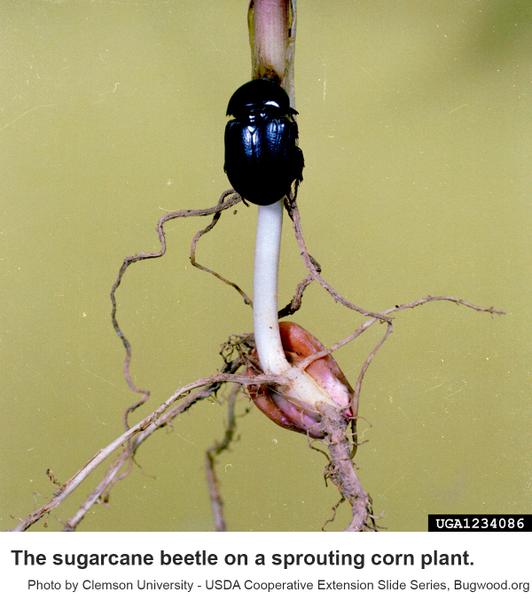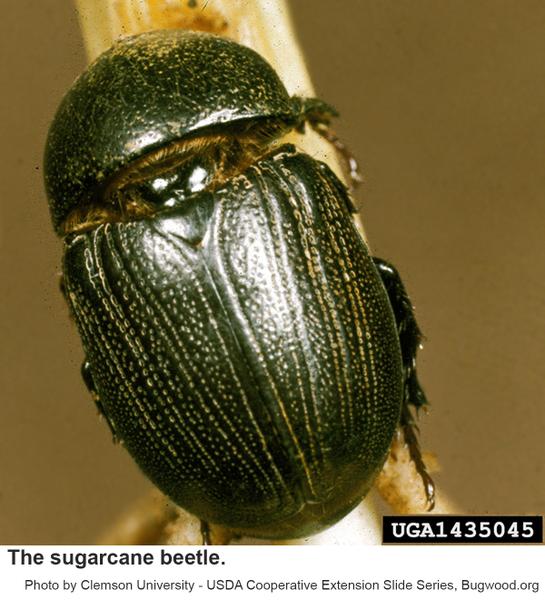Description and Biology
The sugarcane beetle, Euetheola rugiceps, is a black, hard-shelled beetle is dome-shaped and faintly ribbed, has strong legs with coarse spines. It is about a half inch long. When first deposited, the smooth, white egg is oval and about the size of a pinhead. Before it hatches, it gradually enlarges until it is spherical and about twice its original size. The larva grows to just over and inch long and is dirty white grub with a brick red head, pale brown legs, and a dark abdomen. The pupa is about 0.75 inch long and changes from white to pale brown as it matures.
Adult beetles hibernate during the winter in the soil of well-drained sod. Although they may become active on warm days in late fall or winter, they normally do not resume continual activity until late March or early April. After mating in the soil, females each deposit clusters of three or four eggs in earthen cells. Approximately 2 weeks later, larvae emerge and begin feeding on decaying vegetable matter occasionally molting as they grow. Grubs also feed on roots and crowns of turfgrasses. After 2 or 3 months, mature grubs enter a 2-week pupal period. Emerging in August and September, a new generation of adults feeds for a short time before entering hibernation. One generation occurs each year.
Host Plants
Although the sugarcane beetle is primarily a problem on corn, sugarcane, and rice, it also infests cotton, strawberry, rose, and grasses. The adults can be a nuisance as they are attracted to porch lights. In lawns, sugarcan beetles usually infest bermudagrass, but have also been found on zyosiagrass. Adults may be found dead or crawling along the grass surface during the day although most activity occurs during early night. Adults can also be found just under the turf, and are suspected to feed on the roots and crowns of turfgrass.The larvae are most likely found in bermudagrass and other warm season grasses as well. It is unknown what they feed on but the organic matter in the thatch and soil is probably the main component of their diet. Damage to turfgrass is presumed to be caused solely by the adults tunneling as well as brown damaging roots and crowns. Birds may prey on these beetles during the day and cause additional damage to turfgrass as they dig after the beetles and grubs.
Residential Recommendations
Sugarcane beetles occasionally damage turfgrass to the point that suppression is warranted. Current recommendations are aimed primarly at the adult beetles as these beetles are active above ground especially at night. Pyrethoid insecticides are sufficiently labeled for use in home grounds. When used as directed, pyrethroids are very toxic to insects but are not particularly hazardous to humans and pets (other than fish-avoid using pyrethroids around pools, ponds, and streams).
References
- Biology and Management of the Sugarcane Beetle (Coleoptera: Scarabaeidae) in Turfgrass. Billeisen, T. L. and R. L. Brandenburg. 2014. Journal of Integrated Pest Management, 5 (4).
- Sugarcane Beetles in Turf. Billeisen, T. and R. Brandenburg. No Date. TurfFiles, NC State Extension.
- Extension Plant Pathology Publications and Factsheets
- Horticultural Science Publications
- North Carolina Agricultural Chemicals Manual
For assistance with a specific problem, contact your local N.C. Cooperative Extension Center.
This Factsheet has not been peer reviewed.
Publication date: April 27, 2015
Reviewed/Revised: Nov. 22, 2024
Recommendations for the use of agricultural chemicals are included in this publication as a convenience to the reader. The use of brand names and any mention or listing of commercial products or services in this publication does not imply endorsement by NC State University or N.C. A&T State University nor discrimination against similar products or services not mentioned. Individuals who use agricultural chemicals are responsible for ensuring that the intended use complies with current regulations and conforms to the product label. Be sure to obtain current information about usage regulations and examine a current product label before applying any chemical. For assistance, contact your local N.C. Cooperative Extension county center.
N.C. Cooperative Extension prohibits discrimination and harassment regardless of age, color, disability, family and marital status, gender identity, national origin, political beliefs, race, religion, sex (including pregnancy), sexual orientation and veteran status.


